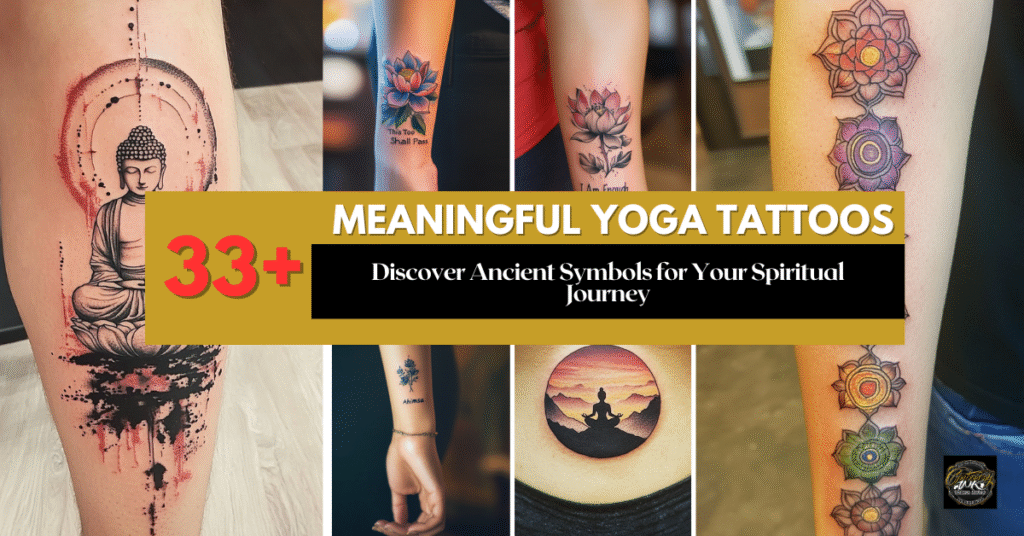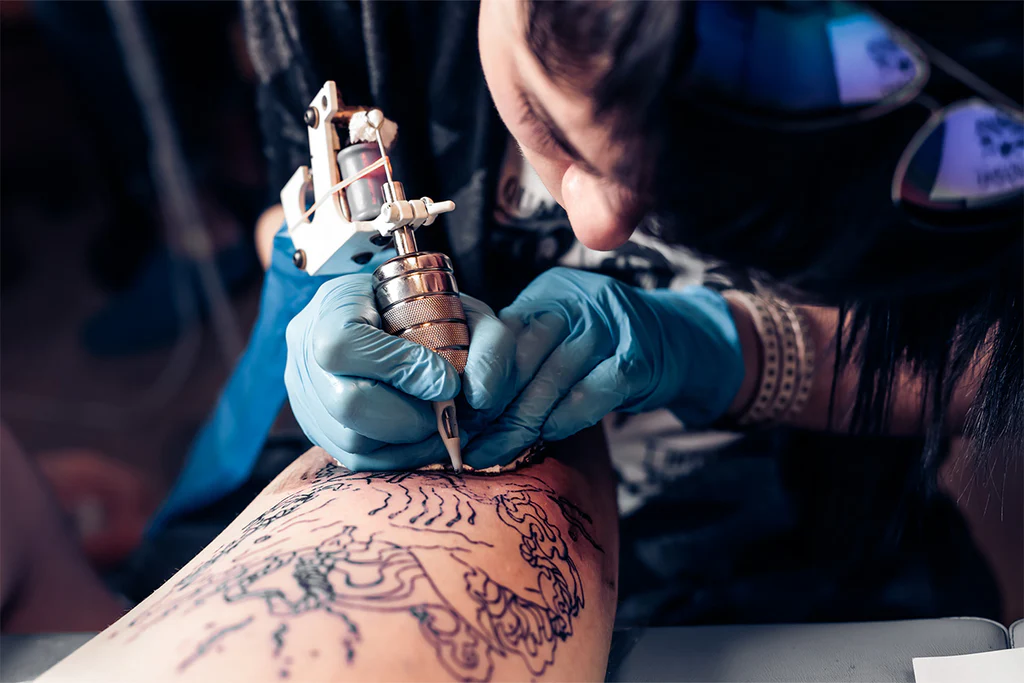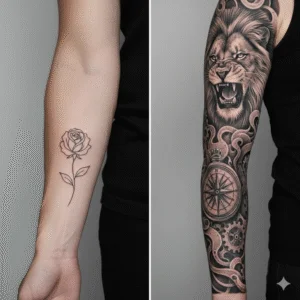Looking for a meaningful way to showcase your devotion to yoga? Yoga tattoos beautifully blend spiritual symbolism with personal expression, creating permanent reminders of your journey on the mat. These artful designs aren’t just trendy body art—they’re powerful statements about your commitment to mindfulness, balance, and inner peace.
Whether you’re considering your first tattoo or adding to your collection, yoga-inspired ink offers endless possibilities. From delicate Om symbols and intricate mandalas to flowing lotus flowers and sacred geometry, these designs carry deep significance rooted in ancient traditions. You’ll find that each symbol connects to different aspects of yoga philosophy, allowing you to wear your intentions directly on your skin.
10 Inspirational Yoga Tattoos to Express Your Inner Zen
1. Om Symbol Tattoo
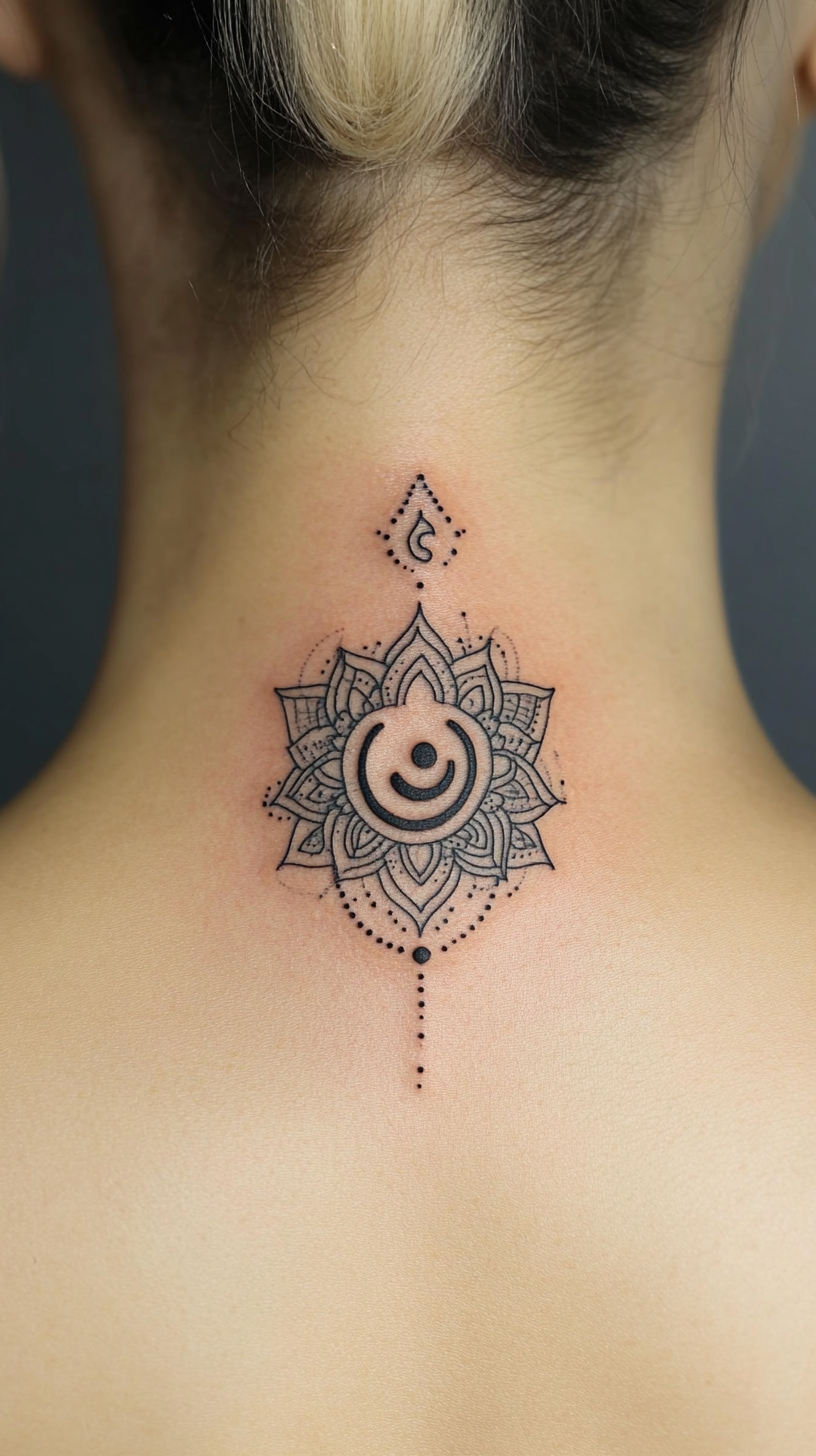
The Om symbol represents the primordial sound of the universe in yoga philosophy. Getting this tattoo on your wrist, back, or behind your ear serves as a powerful reminder of your connection to universal consciousness. Minimalist line-art versions work beautifully for smaller placements, while more elaborate designs with mandalas or lotus backgrounds make stunning statement pieces. Many yoga practitioners choose this symbol for its instant recognition within the yoga community and its ability to center your thoughts during challenging moments.
2. Lotus Flower Tattoo
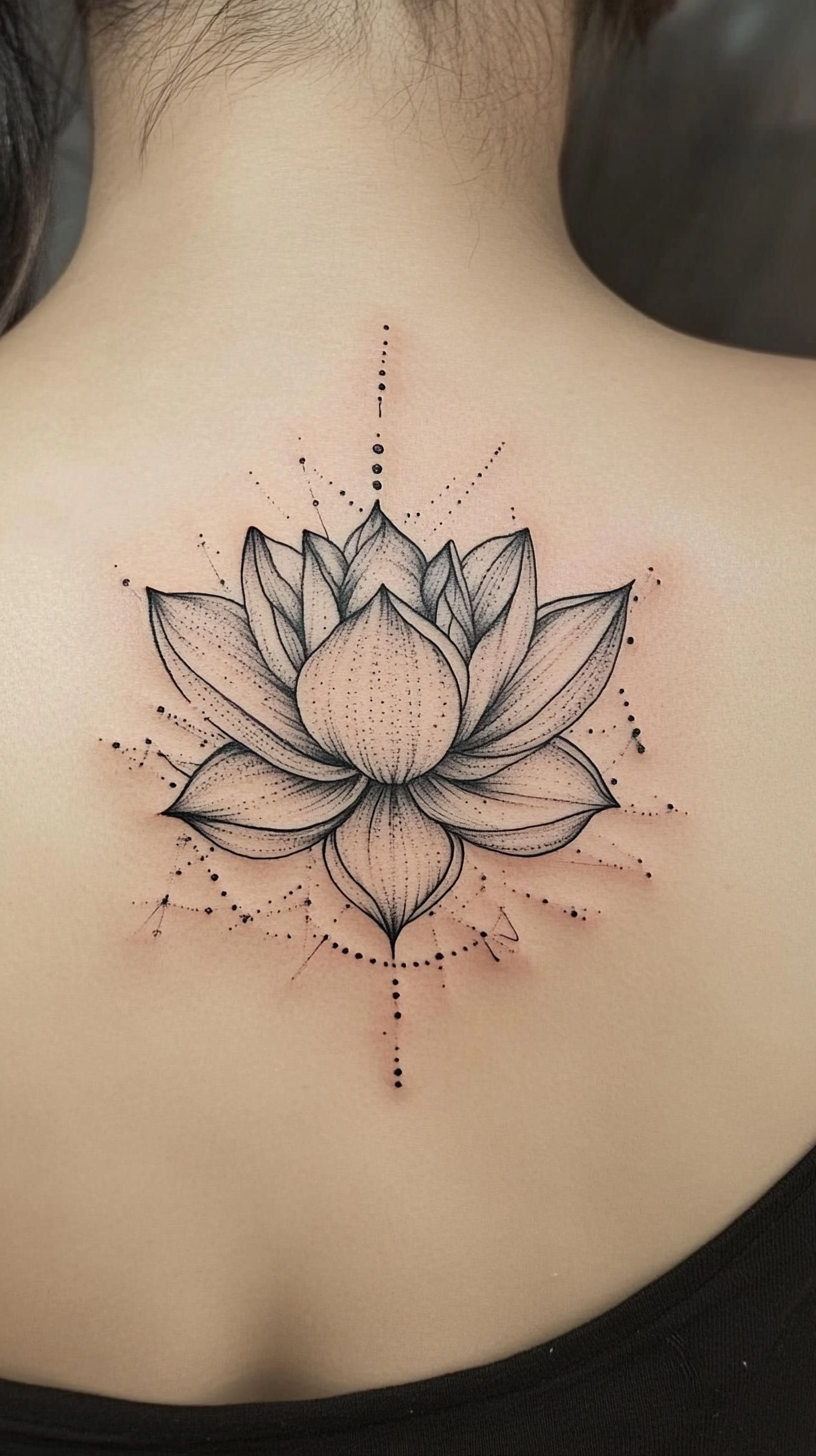
A lotus flower tattoo symbolizes spiritual awakening and purity as it rises from muddy waters to bloom beautifully. You’ll find this design particularly meaningful if your yoga journey has helped you overcome difficulties. Popular placements include the upper back, shoulder blade, or sternum. Some designs show the flower in various stages of blooming to represent personal growth, while others incorporate water elements to emphasize the lotus’s journey from darkness to light.
3. Buddha Silhouette Tattoo

The serene silhouette of Buddha in meditation pose embodies peace and enlightenment. This tattoo serves as a reminder to maintain tranquility amidst life’s chaos. The design works well on the upper arm, back, or calf, with minimalist black outlines creating an elegant look. Some practitioners add lotus flowers or mandala patterns around the Buddha figure to enhance its spiritual significance and visual appeal.
4. Seven Chakras Tattoo
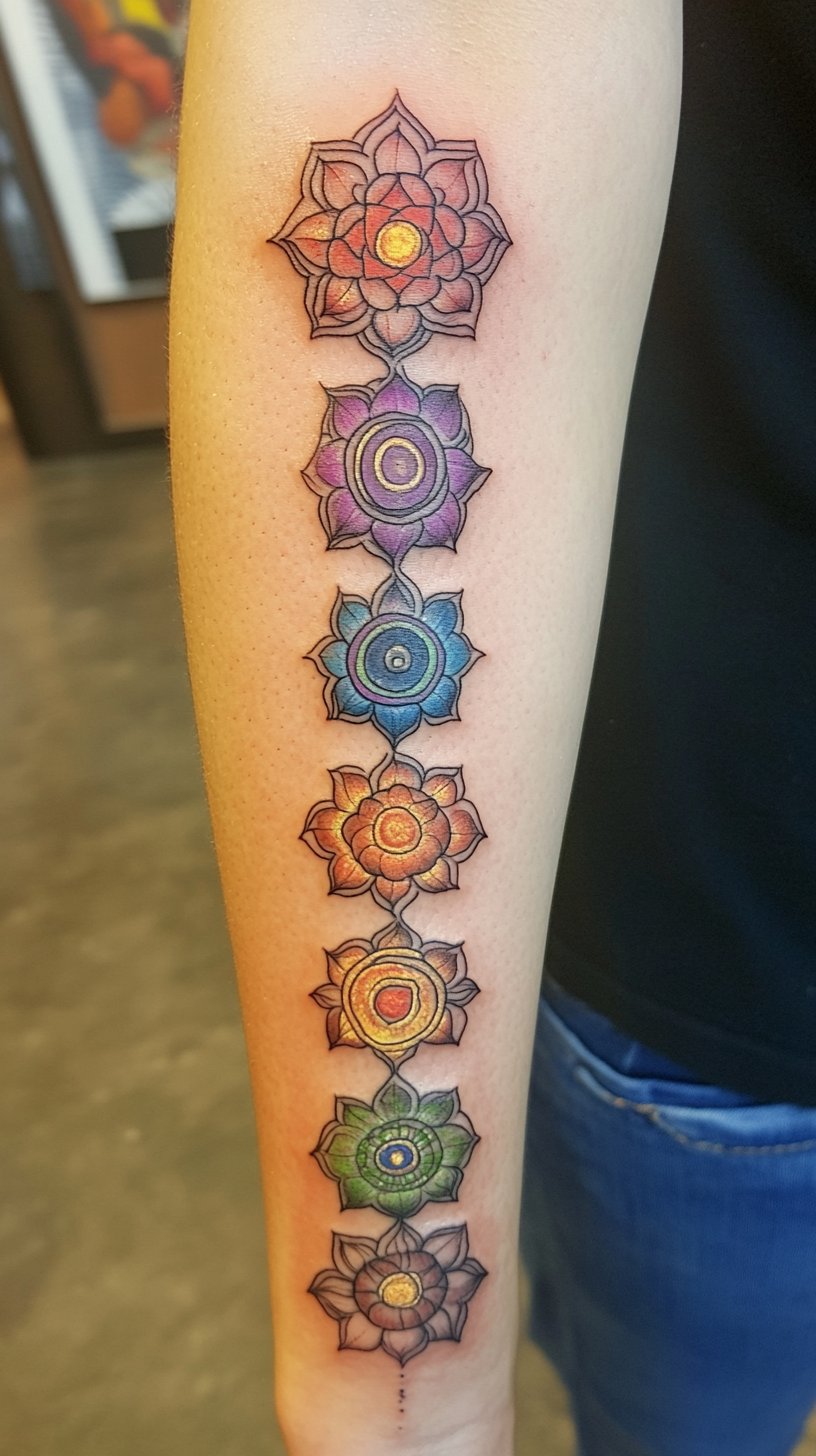
A vertical alignment of the seven chakras makes for a visually striking tattoo that represents energy flow and balance. This design typically includes the vibrant colors associated with each chakra—from red at the root to violet at the crown. It’s commonly placed along the spine, forearm, or side of the ribcage. You can choose between realistic depictions or geometric representations, with some designs incorporating Sanskrit symbols for each chakra.
5. Sanskrit Mantra Tattoo
Sanskrit mantras like “Om Shanti” (peace) or “So Hum” (I am that) offer profound meaning in elegant script. These tattoos serve as personal affirmations and powerful reminders of your yoga intentions. Delicate placement along the inner forearm, collarbone, or behind the neck allows for private reflection. The flowing nature of Sanskrit characters creates a beautiful, artistic element that stands alone or complements other yoga-inspired designs.
6. Unalome Tattoo
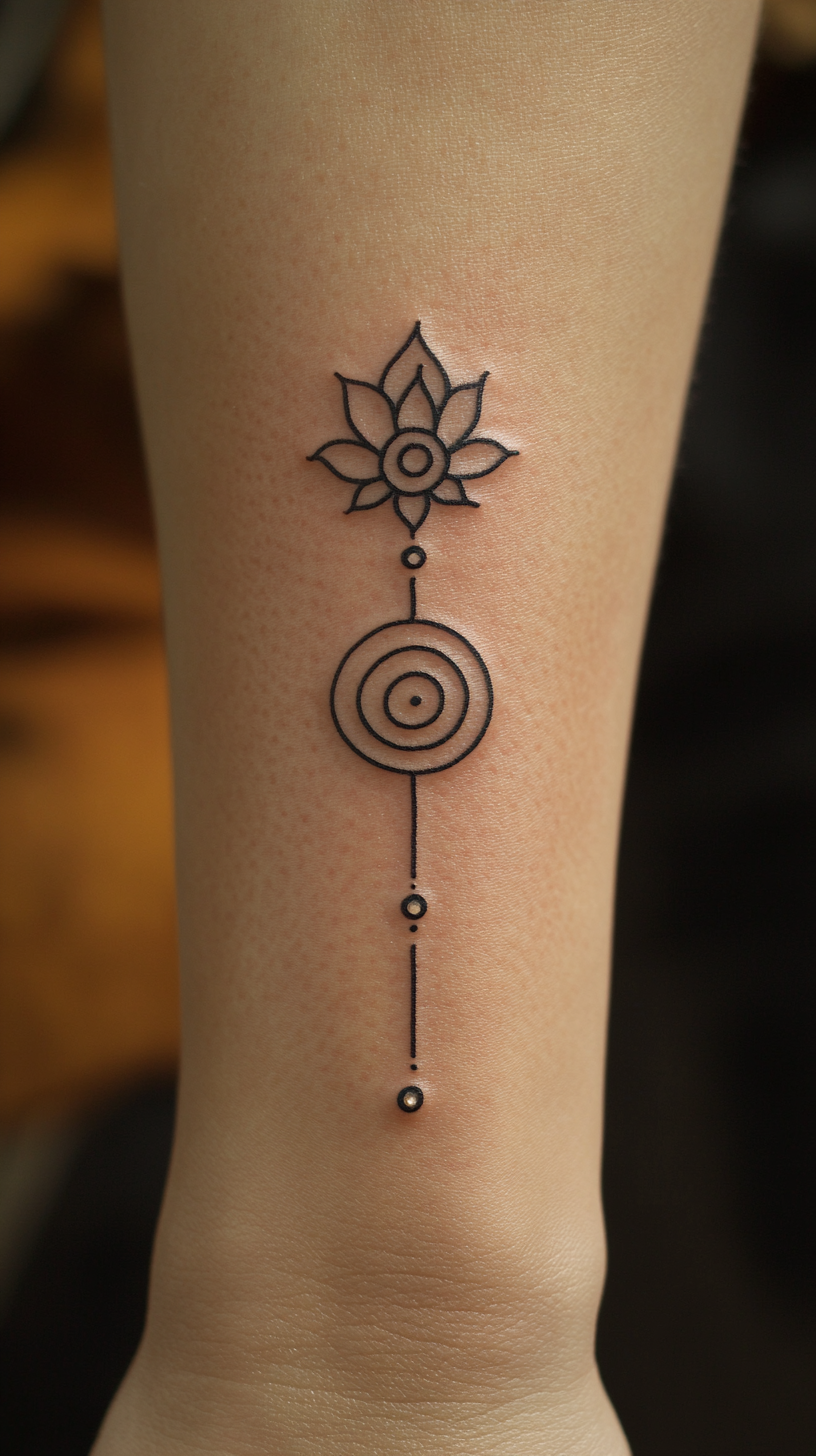
The Unalome symbol represents the path to enlightenment, with its spiral base indicating life’s chaotic beginnings and the straight line signifying eventual clarity. This design works beautifully as a standalone piece on the wrist, back of neck, or finger. Many yogis combine Unalomes with lotus flowers or add small gemstone-like details to represent obstacles overcome. The simplicity of this design makes it perfect for those who prefer subtle spiritual tattoos.
7. Hamsa Hand Tattoo
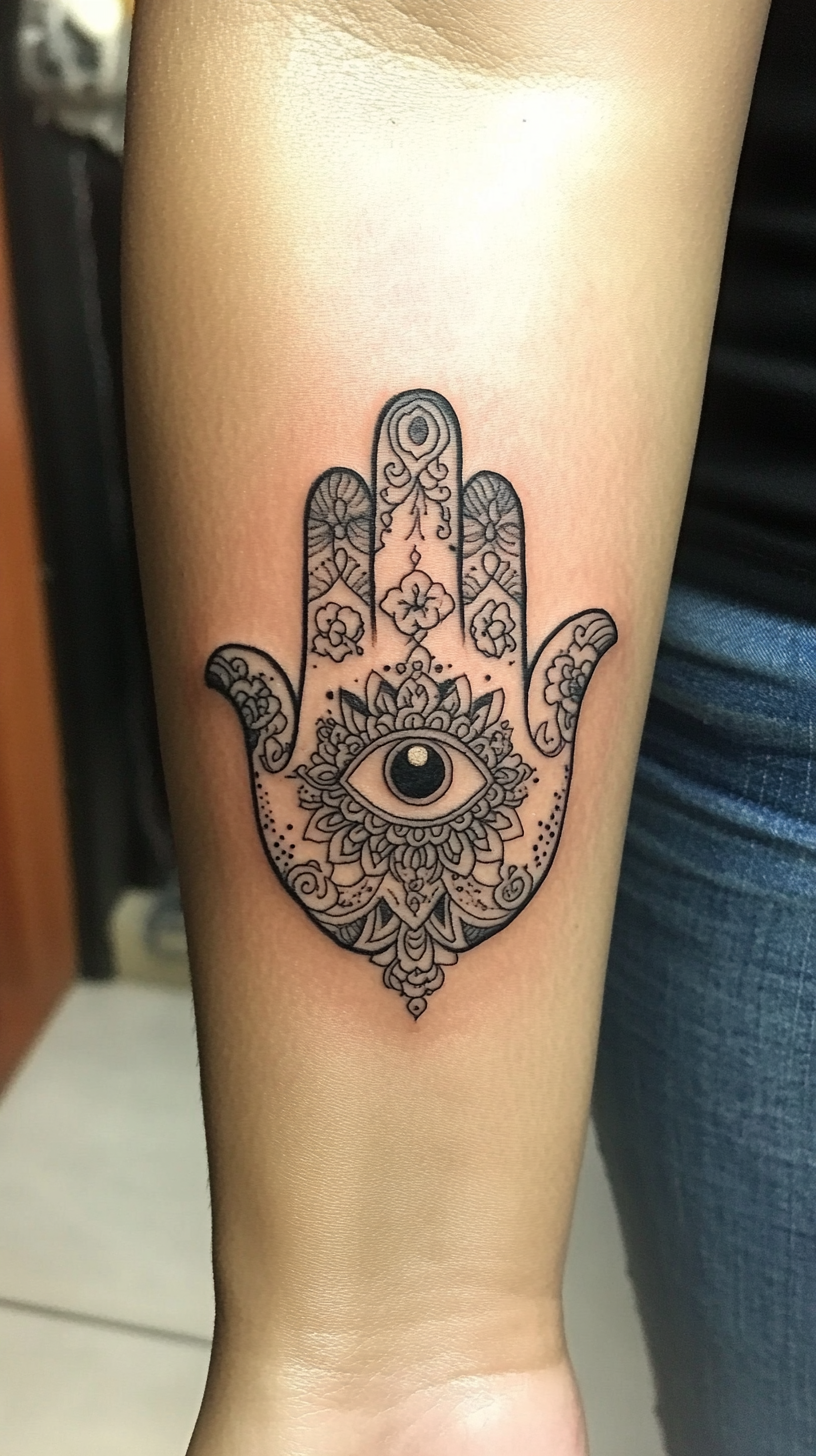
The Hamsa hand symbolizes protection and divine power, making it a meaningful yoga tattoo that combines spiritual significance with artistic beauty. Often featuring an eye in the center and intricate patterns, this design offers protection from negative energies. Popular placements include the back of the hand, forearm, or shoulder blade. You can personalize your Hamsa with mandala patterns, Om symbols, or elements that represent personal obstacles you’ve overcome through your yoga practice.
8. Meditation Pose Silhouette Tattoo
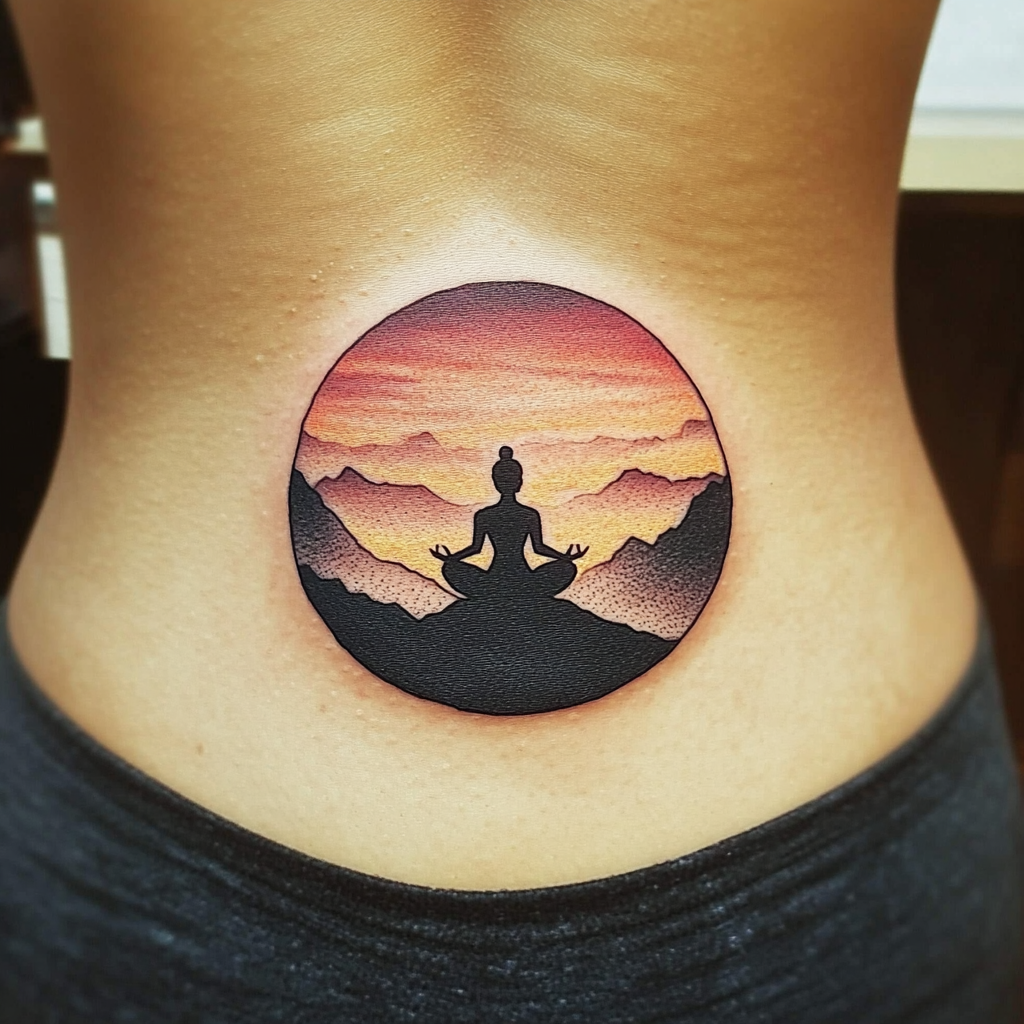
A simple silhouette of a person in lotus position (Padmasana) creates an instantly recognizable yoga tattoo. This design represents dedication to meditation practice and inner peace. It works well on the ankle, upper arm, or back of the neck. Some variations incorporate a sunset background or place the figure on a mountain peak to symbolize spiritual elevation. The simplicity of this design allows for easy scaling, making it suitable for both tiny, discreet tattoos and larger statement pieces.
9. Sacred Geometry Tattoo
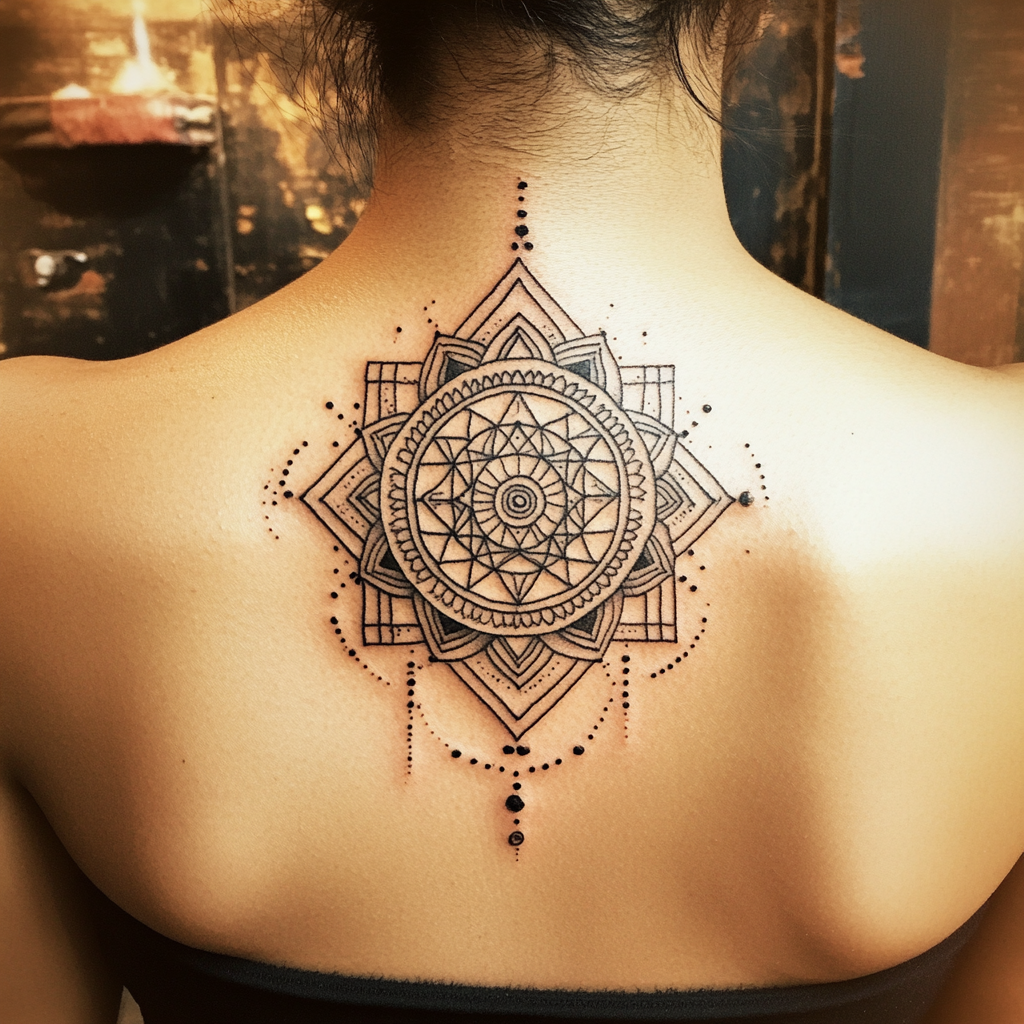
Sacred geometry patterns like the Flower of Life or Sri Yantra represent the mathematical patterns that form everything in the universe. These intricate designs connect yoga philosophy with universal order and harmony. Their detailed nature makes them ideal for larger areas like the upper back, thigh, or chest. You can choose black line work for a classic look or incorporate watercolor elements for a modern interpretation. These designs particularly appeal to those drawn to both the spiritual and scientific aspects of yoga.
10. “Breathe” Script Tattoo
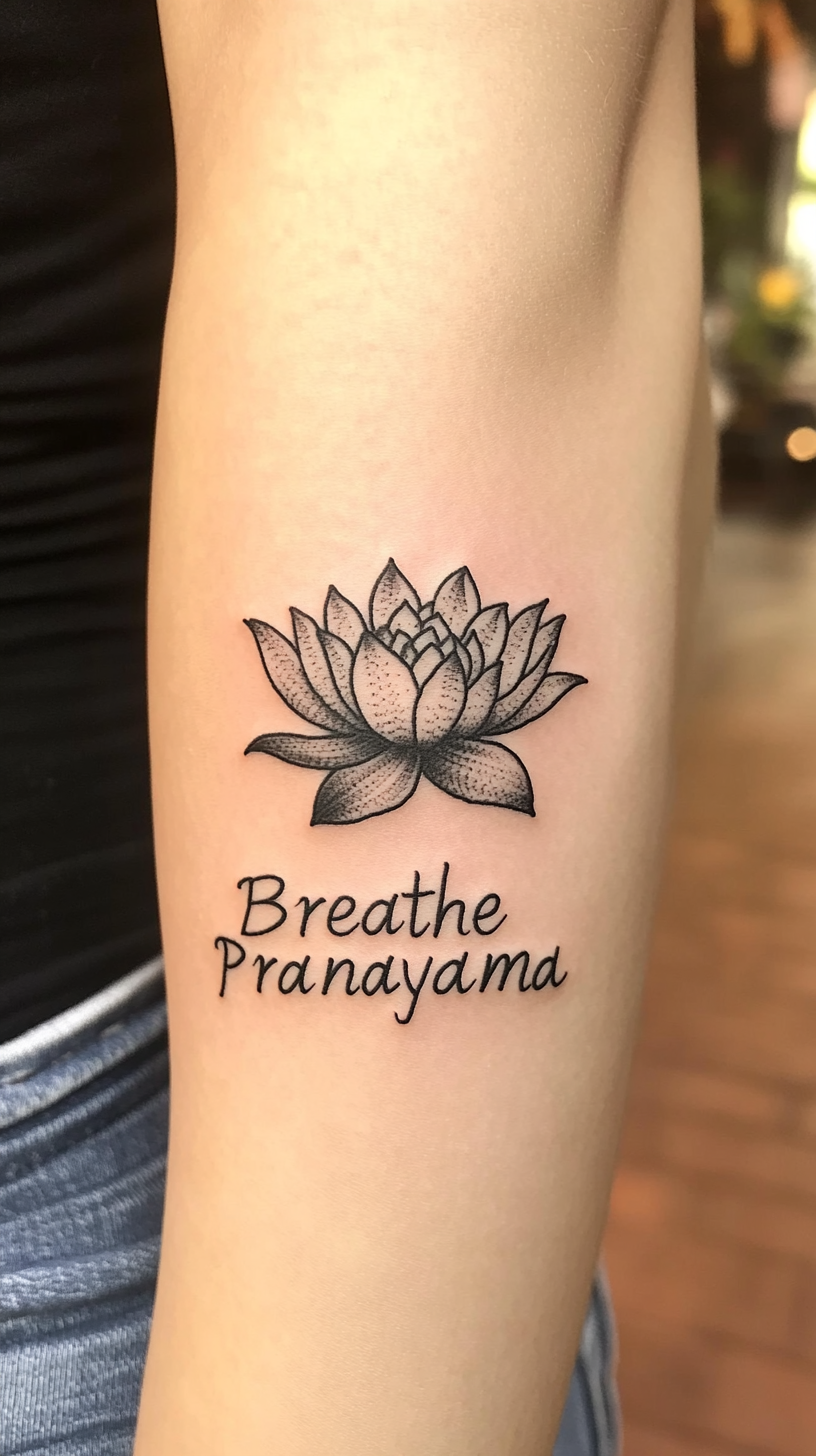
A simple “Breathe” script tattoo serves as a constant reminder of yoga’s foundational practice—conscious breathing. This minimalist design works beautifully on the wrist, inner arm, or collarbone where you’ll see it during challenging moments. You can choose elegant script fonts or opt for Sanskrit translation (“Pranayama”) for added spiritual significance. Some yogis incorporate small lotus flowers or tiny Om symbols to enhance the design while maintaining its clean simplicity. This tattoo resonates especially with those who practice yoga for anxiety management and mindfulness.
The Ancient Origins of Yoga Symbolism in Body Art
Traditional Sanskrit Symbols and Their Meanings
Sanskrit symbols have decorated human bodies long before modern tattoo machines existed. These ancient markings date back over 5,000 years to the Indus Valley civilization, where yogic practices first emerged. Early yoga practitioners used henna and natural pigments to adorn their bodies with sacred symbols during rituals and ceremonies. The Om symbol (ॐ), one of the most recognized Sanskrit characters, represents the primordial sound of creation and consciousness. Equally important is the “Aum” written in Devanagari script, which embodies the trinity of creation, preservation, and destruction.
Other powerful Sanskrit symbols include “Sat Nam” (true identity), “Lokah Samastah Sukhino Bhavantu” (may all beings be happy and free), and “Ahimsa” (non-violence). These symbols weren’t merely decorative—they served as spiritual tools for meditation, protection, and manifestation. Ancient yogis believed that carrying these symbols on their skin created a permanent connection to exact energies and deities. Today’s yoga enthusiasts often choose these same symbols as tattoos to honor this rich tradition while expressing their personal spiritual journey.
How Yoga Philosophy Translates to Tattoo Design
Yoga philosophy transforms into meaningful tattoo designs through intentional symbolism that connects ancient wisdom with modern expression. The concept of non-attachment (vairagya) inspires minimalist tattoos with clean lines and subtle placement. Dharma (life purpose) manifests in personalized designs that represent individual paths, often incorporating direction symbols like arrows or paths. The yamas and niyamas—yoga’s ethical guidelines—appear as tattoos featuring words like “satya” (truthfulness) or visual representations of contentment and self-discipline.
The yogic principle of union between mind, body, and spirit inspires interconnected designs that flow across the body, creating harmony in their placement. Many yoga practitioners choose tattoos that represent their favorite asana (pose), capturing the physical expression of yoga philosophy in a permanent art form. The concept of prana (life force) translates into ever-changing, flowing tattoo designs with elements like wind, water, or flames. These philosophical foundations give yoga tattoos depth beyond mere aesthetics, transforming them into powerful tools for spiritual remembrance and mindful living.
Popular Yoga Symbol Tattoos and Their Significance
Yoga symbols provide rich material for meaningful tattoos, each carrying centuries of spiritual wisdom and cultural significance. These powerful symbols serve as permanent reminders of yoga’s groundbreaking principles while creating visually striking body art.
Om Symbol: The Sacred Sound of the Universe
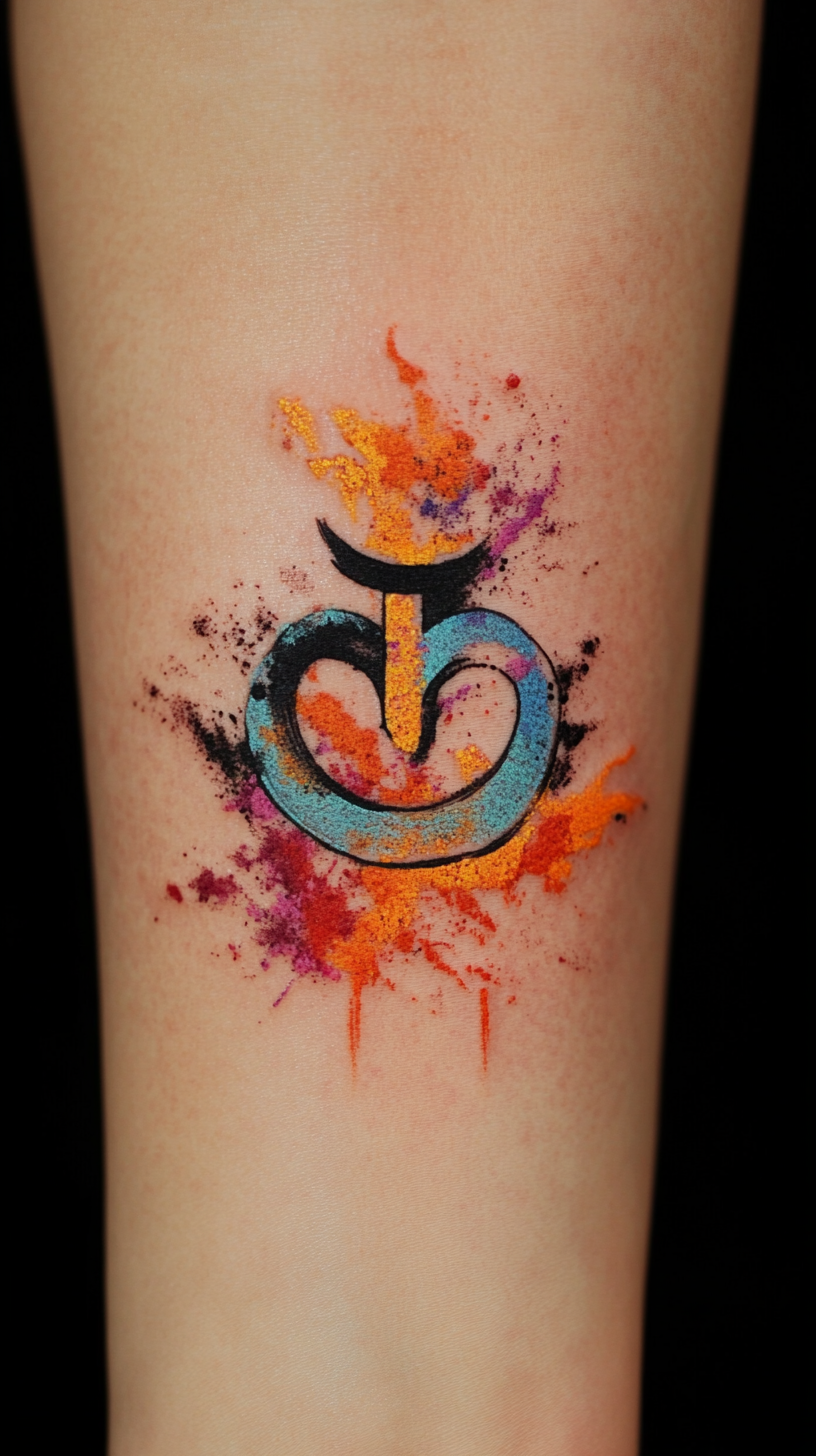
The Om symbol is the most recognized and tattooed yoga emblem, representing the primordial sound that initiated creation. This powerful Sanskrit character embodies the essence of ultimate reality and consciousness. When tattooed on your body, Om serves as a constant reminder of your connection to the universe and your yoga practice. Many practitioners choose to place Om tattoos on their wrists, back of the neck, or inner forearm for daily visibility. The symbol’s curved lines and distinctive dot create an elegant design that works beautifully in both minimalist black ink or colorful interpretations.
Lotus Flower: Purity and Enlightenment
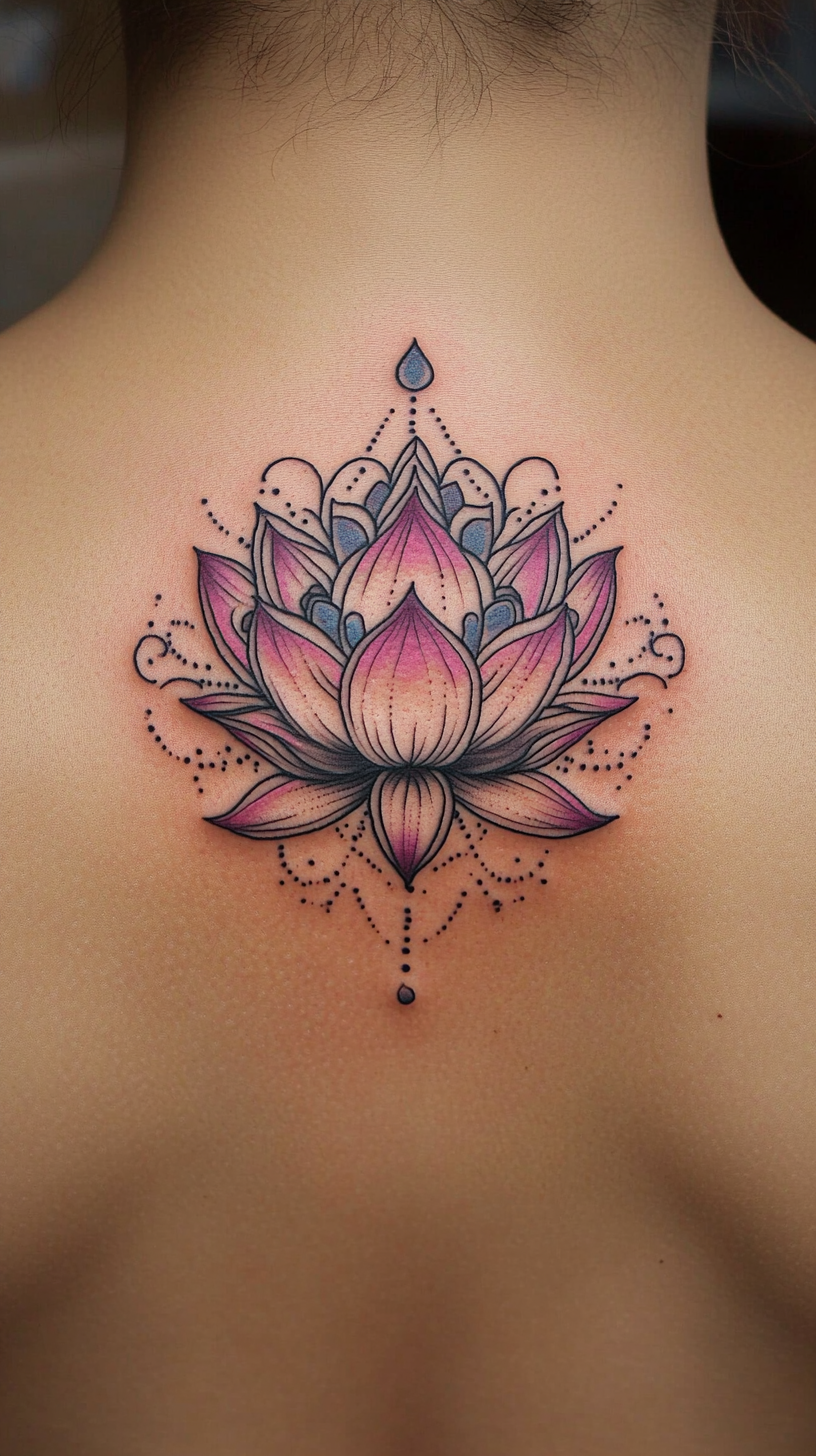
Lotus flower tattoos symbolize spiritual awakening and the journey from darkness to light. Just as the lotus grows from muddy waters to bloom immaculately above the surface, this tattoo represents your ability to rise above life’s challenges with grace. The lotus design offers versatility—from simple outlines to intricate detailed blossoms with multiple petals. Popular placements include the back, shoulder blades, and sternum. Each color carries exact meaning: white lotus tattoos represent purity, pink symbolizes the Buddha’s teachings, while blue lotuses signify wisdom and knowledge. Many yogis incorporate lotus flowers with other elements like mandalas or Om symbols for more personalized significance.
Unalome: The Path to Enlightenment
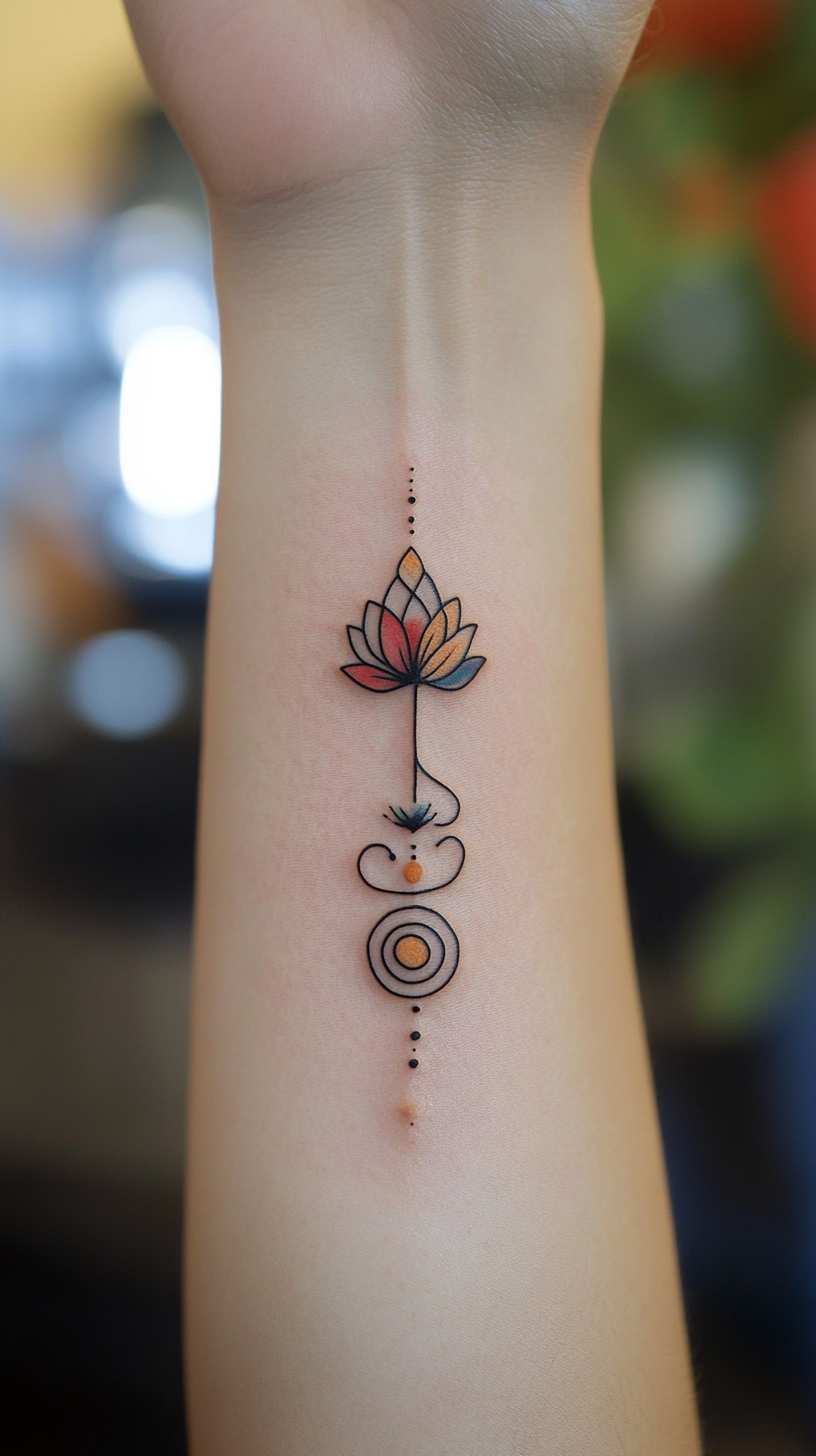
Unalome tattoos depict your spiritual journey through a single, elegant line. The spiral base represents life’s confusions and struggles, while the straight portion signifies achieving enlightenment and clarity. Originally from Buddhist tradition, these designs have become popular in yoga communities for their profound meaning and minimalist aesthetic. Unalome tattoos work perfectly on your wrist, finger, spine, or behind your ear. Many practitioners personalize their Unalome by adding lotus flowers, moons, or stars to the design. The simplicity of this symbol makes it ideal for first-time tattoo enthusiasts who want meaningful but subtle body art.
Mandala: Sacred Geometry and Wholeness
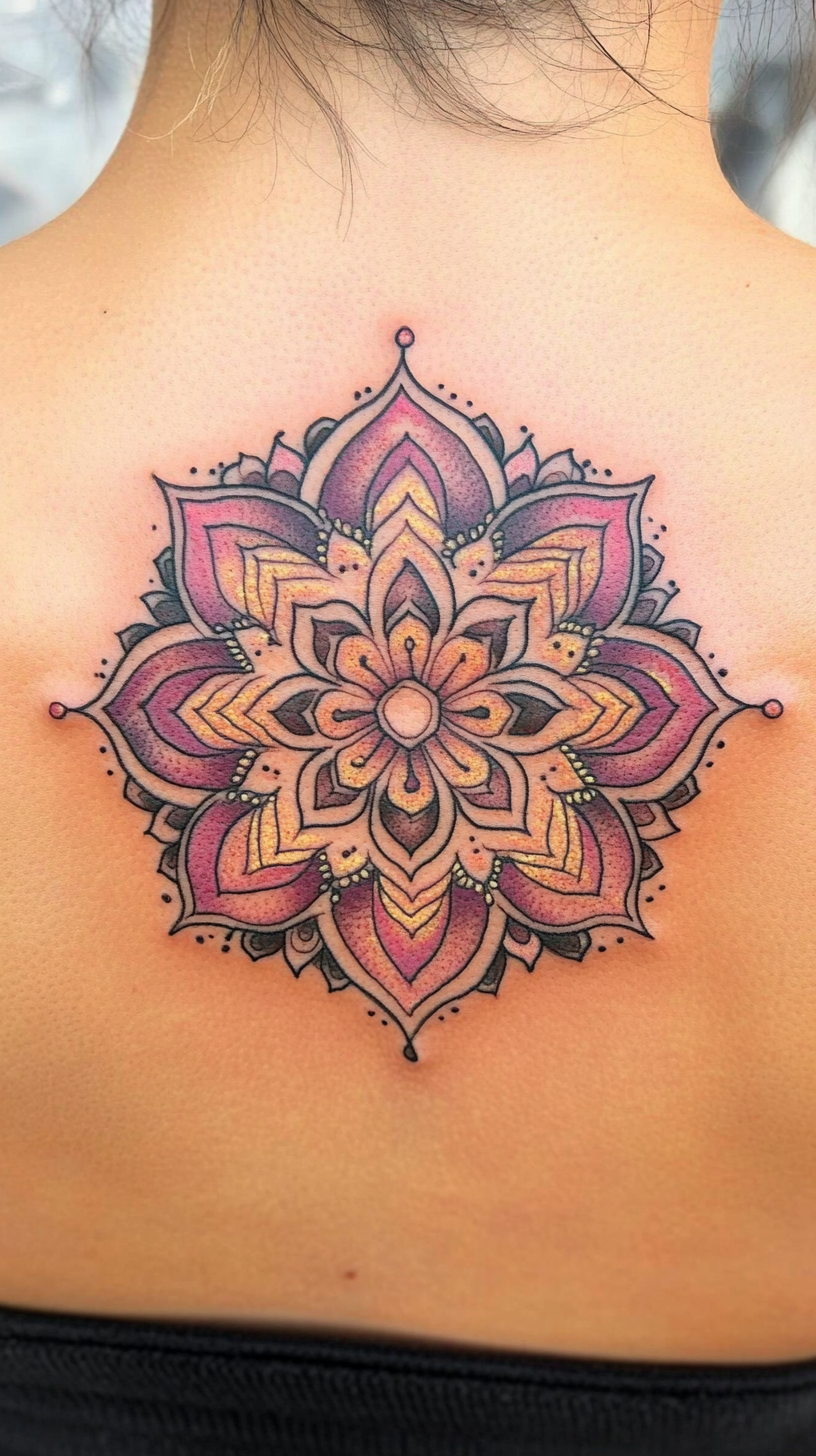
Mandala tattoos represent the universe and cosmic wholeness through intricate geometric patterns. These circular designs symbolize balance, eternity, and the integration of mind, body, and spirit. When you choose a mandala tattoo, you’re embracing the concept of unity and completeness. These detailed designs work beautifully as larger pieces on your back, chest, or thigh, allowing the intricate patterns to be fully appreciated. Many yoga practitioners customize mandalas with personal elements like lotus petals, chakra colors, or sacred geometry. The creation process of a mandala tattoo often becomes a meditation itself, with artists carefully crafting these symmetrical patterns that draw the eye inward—just as meditation draws attention to your center.
Breathtaking Yoga Pose Tattoos for Movement Enthusiasts
Warrior Pose Silhouettes
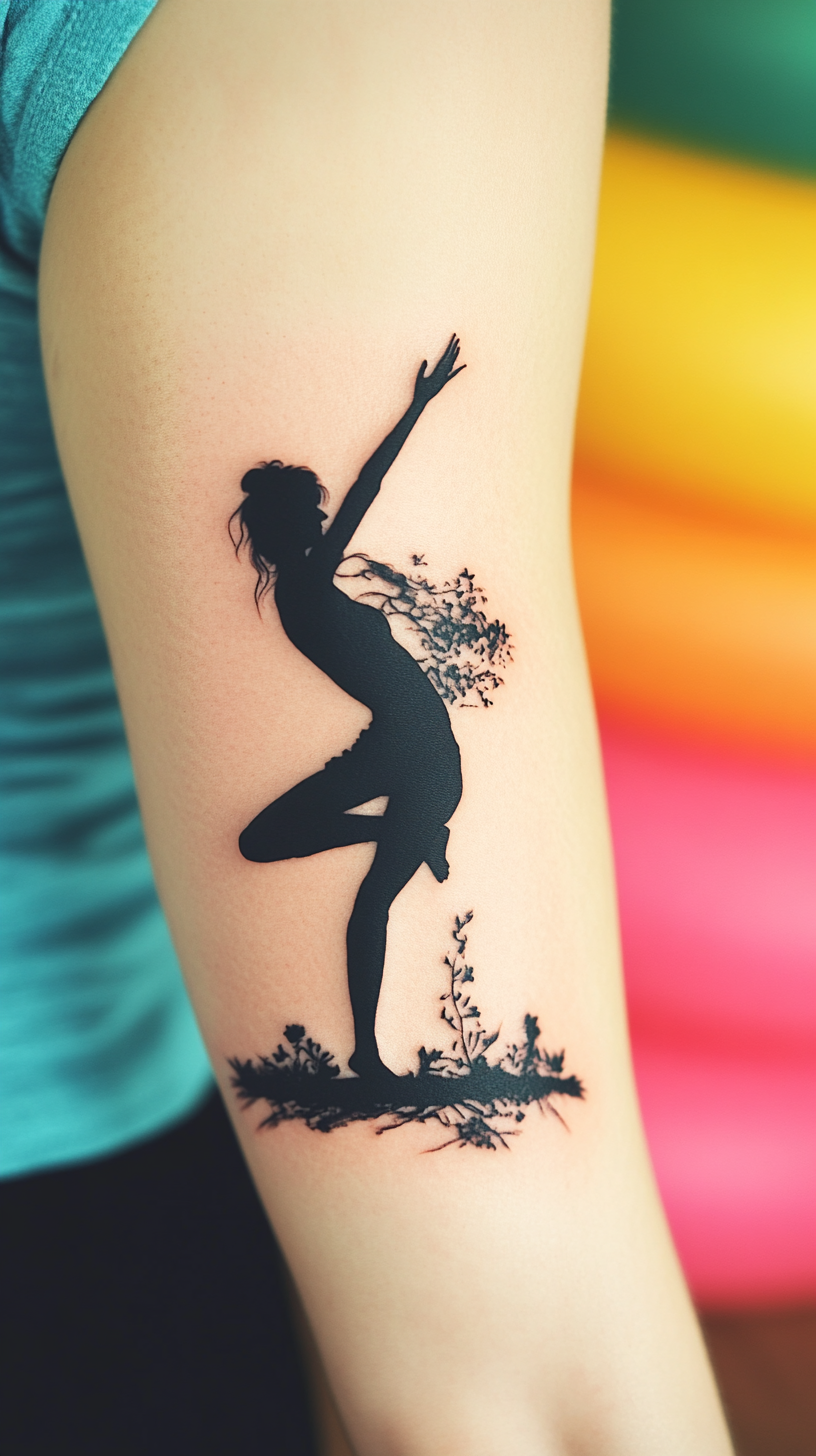
Warrior pose tattoos capture the strength and determination embodied in yoga practice. These powerful silhouettes showcase the body in positions of balance, focus, and intention—making them perfect for practitioners who connect deeply with these foundational poses. Many yoga enthusiasts choose Warrior I (Virabhadrasana I) tattoos for their representation of courage, with the figure standing tall, arms reaching skyward. Warrior II tattoos display the body in profile with arms extended horizontally, symbolizing patience and perseverance. These designs work beautifully as minimalist black ink silhouettes on forearms, shoulder blades, or calves, where the flowing lines can follow your body’s natural contours. For a more distinctive approach, try incorporating watercolor elements behind the silhouette or adding geometric patterns that represent your personal yoga journey.
Flowing Vinyasa Sequences
Vinyasa flow tattoos beautifully capture the rhythmic movement between yoga poses that characterizes this ever-changing practice style. These tattoos typically feature a series of connected silhouettes showing the body transitioning through several poses, creating a visual representation of breath-synchronized movement. Many yogis choose to immortalize their favorite flow sequence—from Sun Salutations to creative transitions—in a linear design that wraps around wrists, ankles, or forearms. The continuous line art technique works particularly well for these tattoos, using a single unbroken line to trace the movement between poses. For a more elaborate design, consider incorporating elements like breath indicators with small dots or waves between poses, or add subtle color gradients that shift with each position. These tattoos serve as powerful reminders of the fluid nature of practice and the importance of moving mindfully through both yoga and life.
Mindful Placement: Where to Position Your Yoga Tattoo
The location of your yoga tattoo can enhance its meaning and visibility, creating harmony between the symbol and your body’s energy centers.
Chakra-Aligned Tattoo Locations
Positioning your yoga tattoo in alignment with exact chakras can amplify its spiritual significance:
- Crown Chakra (Sahasrara) – Place enlightenment symbols like the lotus flower or Om at the top of your head or upper scalp for connection to higher consciousness.
- Third Eye Chakra (Ajna) – Position intuition-related designs such as the Om symbol or sacred geometry on your forehead or between your eyebrows to enhance perception.
- Throat Chakra (Vishuddha) – Situate communication mantras or blue lotus designs on your throat, collarbone, or back of neck to promote self-expression.
- Heart Chakra (Anahata) – Place love-centered symbols like the Anahata yantra or lotus on your chest, sternum, or upper back to nurture compassion.
- Solar Plexus Chakra (Manipura) – Position empowerment symbols like the Manipura mandala or Warrior pose silhouettes on your abdomen or lower ribcage to boost confidence.
- Sacral Chakra (Svadhisthana) – Situate creativity-focused designs like flowing water symbols or orange lotus flowers on your lower abdomen or lower back.
- Root Chakra (Muladhara) – Place grounding symbols like the Muladhara yantra or elephant deity Ganesha on your tailbone, hips, or feet to enhance stability.
Meaningful Spots for Maximum Impact
Choose strategic body locations that showcase your yoga tattoo while honoring its deeper meaning:
- Inner Wrist – An ideal spot for mantras like “breathe” or small Om symbols that serve as personal reminders visible throughout your daily activities.
- Spine – Perfect for vertical designs like the seven chakras, Kundalini serpent, or flowing Vinyasa sequences that represent energy movement up the central channel.
- Forearm – Highly visible placement for yoga pose silhouettes or Sanskrit phrases that spark conversations about your practice and beliefs.
- Shoulder Blade – Excellent canvas for larger designs like detailed mandalas or Buddha silhouettes that can be revealed or concealed as desired.
- Ribcage – Side body placement creates an elegant flow for designs like the Unalome or lotus stem, symbolizing the journey through life’s ups and downs.
- Back of Neck – Subtle yet important spot for small symbols like the Om or Hamsa hand that connect to both throat and crown chakras.
- Ankle or Foot – Grounding location for symbols like the lotus or Om that represent your foundation in yoga practice and connection to earth.
- Behind the Ear – Intimate placement for tiny symbols that hold personal significance, visible only when you choose to reveal them.
- Sternum – Powerful central location that aligns with the heart chakra, perfect for mandala designs or Sanskrit words representing love and compassion.
- Inner Bicep – Provides private visibility for meaningful symbols that you can share during practice but keep professional when needed.
Finding the Right Artist for Your Spiritual Ink
Choosing the right tattoo artist for your yoga-inspired ink is as important as selecting the design itself. Your tattoo artist will be translating sacred symbolism onto your body, making their understanding of spiritual imagery crucial to the final result.
Questions to Ask Your Tattoo Artist
When searching for the perfect artist to create your spiritual tattoo, asking the right questions can make all the difference in your experience and results:
- Have you worked with spiritual or yoga-inspired designs before? Artists with experience in this niche will better understand the symbolism and significance behind your chosen design.
- What’s your approach to line work and detail? Many yoga symbols require precise, clean lines and intricate details—ensure your artist excels in these techniques.
- How do you feel about incorporating personal elements into traditional symbols? The best spiritual tattoos often blend ancient symbolism with personal meaning.
- What’s your sterilization and safety protocol? Ahimsa (non-harm) should extend to the tattooing process itself through proper hygiene practices.
- Can you explain your pricing structure? Transparency about costs shows respect for the exchange of energy that occurs during the tattooing process.
- How do you create a comfortable environment during sessions? For spiritual tattoos, the experience itself should align with mindfulness principles.
- What’s your touch-up policy? Understanding aftercare and maintenance ensures your spiritual symbol remains clear and meaningful for years to come.
Portfolios to Look For
When reviewing potential artists’ portfolios, focus on these key elements to find someone who can properly honor your spiritual ink:
- Consistent line work quality across multiple pieces shows the artist can create the clean, precise lines necessary for yoga symbols like Om or Unalome designs.
- Evidence of delicate detailing in mandalas, lotus flowers, or intricate Sanskrit lettering demonstrates their ability to handle complex spiritual imagery.
- Balanced composition in their previous work indicates they understand the importance of harmony and flow—essential qualities in yoga-inspired art.
- Varied skin tones in their portfolio shows their ability to work with different pigmentations, ensuring your symbols will appear as intended on your skin.
- Healed tattoo photos reveal how their work ages over time—particularly important for minimalist spiritual designs where every line matters.
- Experience with dotwork or fine line techniques often used in sacred geometry and mandala tattoos demonstrates technical versatility.
- Similar placement examples to where you want your tattoo can help you visualize the final result and confirm their expertise in working with that body area.
- Creative adaptations of traditional symbols show their ability to personalize ancient imagery while maintaining its spiritual integrity.
Yoga Tattoos as Personal Mantras and Intentions
“So Hum” Sanskrit Tattoo
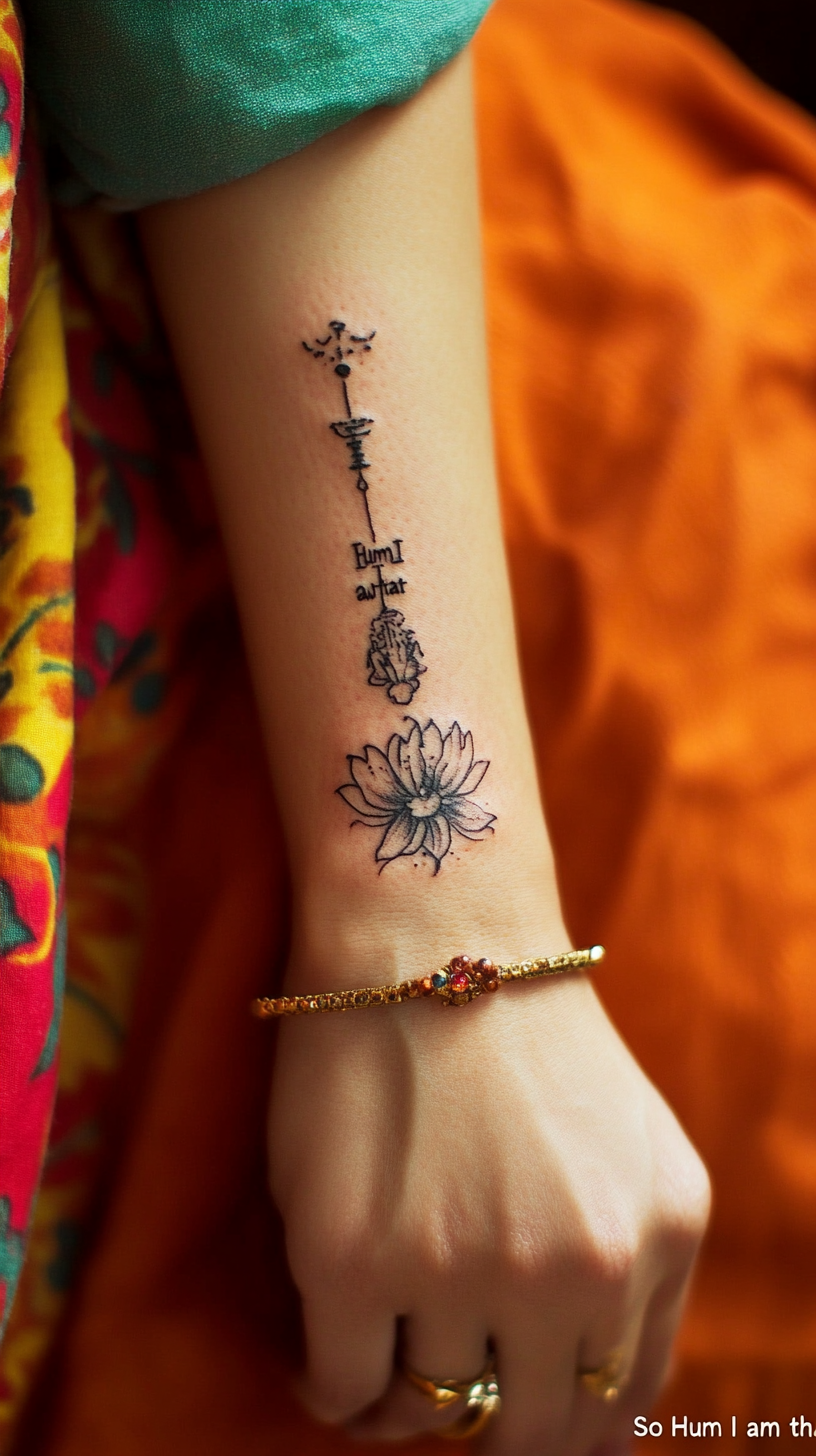
“So Hum” tattoos serve as powerful personal mantras representing “I am that” in Sanskrit. This simple yet profound phrase connects you to the universal consciousness through each breath. When inked on your wrist or forearm, it becomes a constant reminder of your innate divinity and connection to all beings. Many yoga practitioners choose this design in elegant, flowing Sanskrit script to maintain awareness of their breath throughout daily activities, not just during practice.
“Aham Prema” Love Affirmation
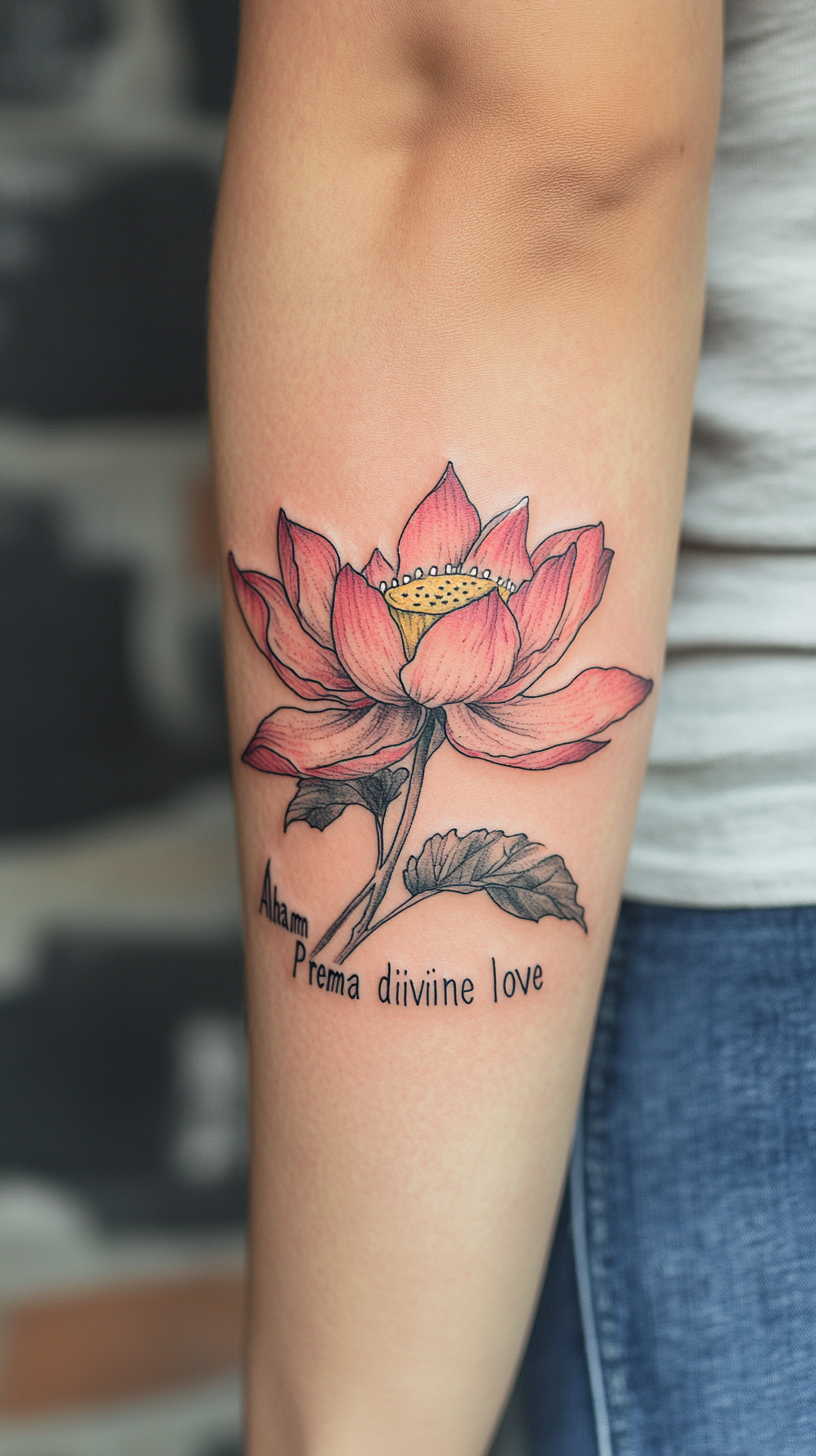
“Aham Prema” translates to “I am divine love” in Sanskrit, making it a perfect mantra tattoo for those focused on heart-opening practices. This tattoo acts as a daily affirmation of your commitment to approaching life with love and compassion. Popular placements include the inner wrist, collarbone, or along the ribcage where it remains private yet accessible. The phrase resonates deeply with yogis who believe love is the ultimate spiritual force guiding their practice.
“Let Go” Minimalist Script
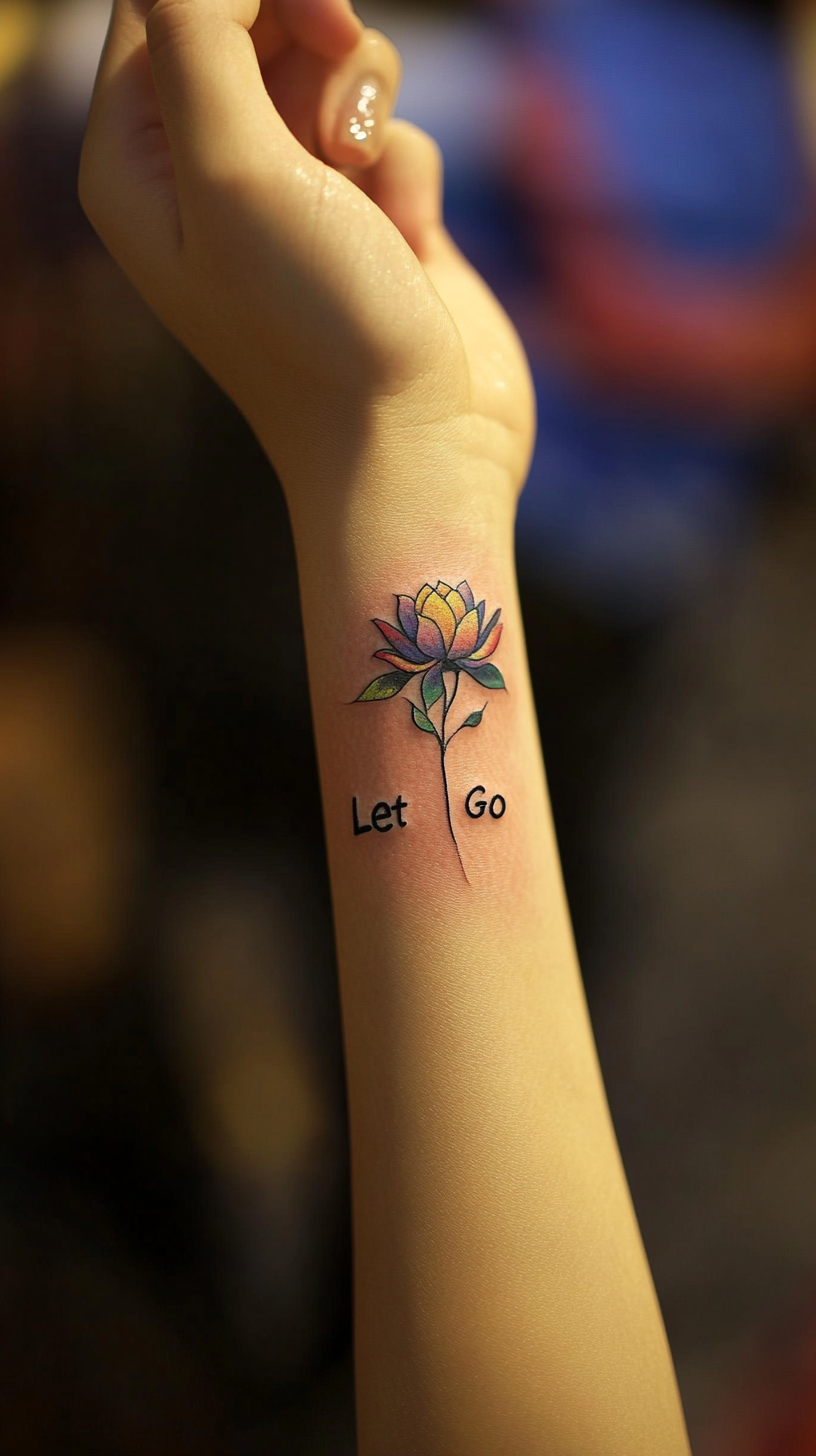
“Let Go” tattoos embody one of yoga’s core principles: non-attachment or aparigraha. This straightforward phrase serves as a constant reminder to release what no longer serves you—whether physical tensions, emotional baggage, or limiting beliefs. These tattoos work beautifully in minimalist script along the forearm, behind the ear, or across the fingers. Many practitioners find this simple mantra helps them maintain perspective during challenging situations both on and off the mat.
“Just Breathe” Reminder

“Just Breathe” tattoos ground you in the present moment through pranayama awareness. This straightforward phrase reconnects you to your breath during stressful situations, serving as a mindfulness tool throughout your day. The simplicity of this design makes it versatile for various placements including wrists, ankles, or along the collarbone. Many yoga practitioners report that glancing at this tattoo creates an immediate shift in their breathing pattern and mental state.
“Ahimsa” Non-Violence Commitment

“Ahimsa” tattoos represent your dedication to the first yama of non-violence in thought, word, and action. This Sanskrit term extends beyond physical harm to cover compassion toward all beings, including yourself. When placed on visible areas like the wrist or forearm, it serves as a gentle prompt to choose kindness in every interaction. Many practitioners find this tattoo helps them pause before reacting negatively, creating space for more mindful responses.
“Sat Nam” Truth Affirmation
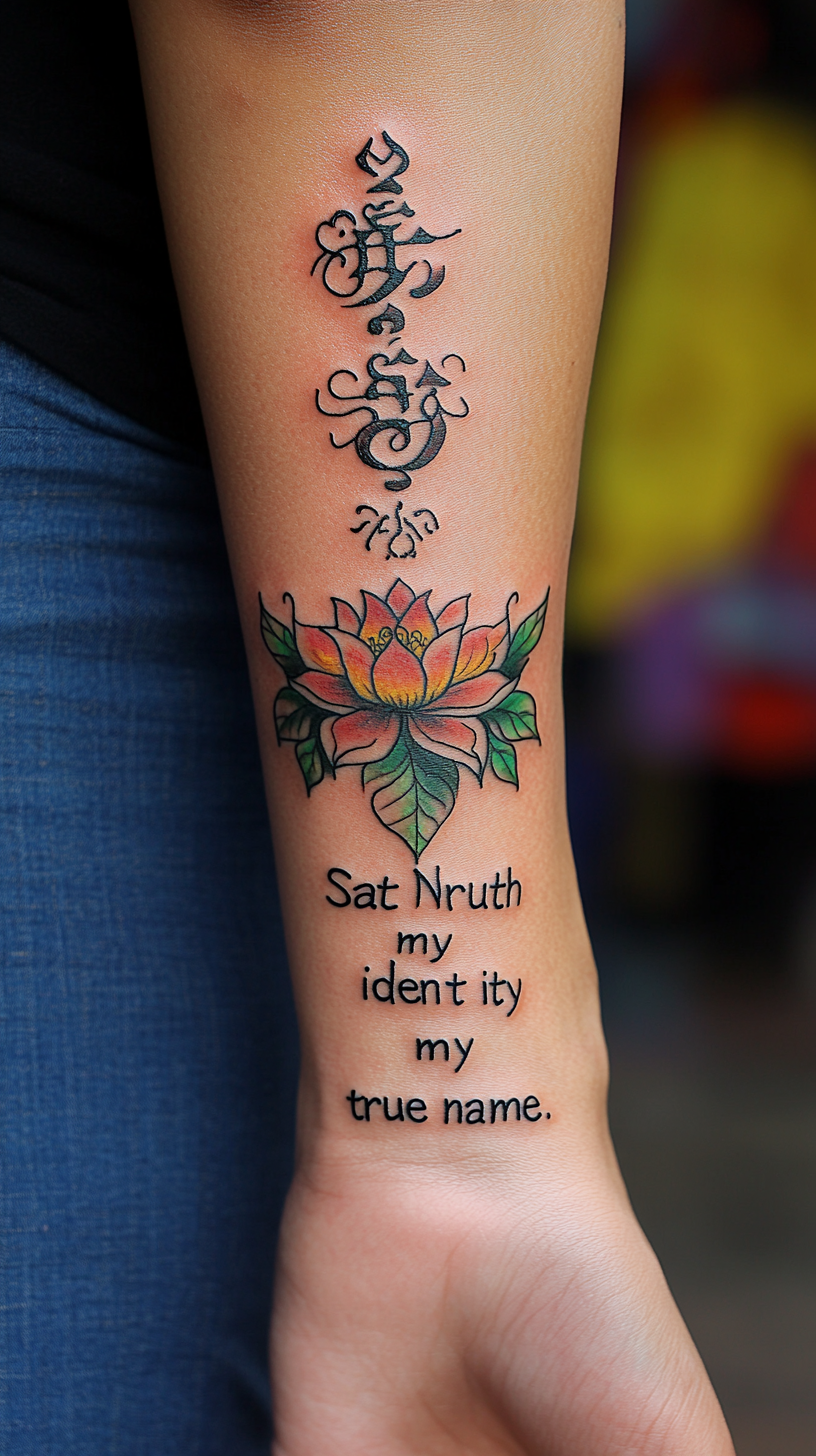
“Sat Nam” tattoos embody the Kundalini yoga mantra meaning “truth is my identity” or “true name.” This powerful phrase affirms your commitment to living authentically and speaking your truth. Commonly inked in Sanskrit script along the forearm, wrist, or back of the neck, it serves as a personal integrity check throughout your day. The mantra reminds you to align your actions with your highest self, making it particularly meaningful for those who’ve struggled with authenticity.
Intention Word in Sanskrit

Sanskrit intention word tattoos transform your personal mantra into sacred symbolism. Words like “Shanti” (peace), “Santosha” (contentment), or “Karuna” (compassion) carry deeper resonance when written in the ancient language of yoga. These tattoos connect you to thousands of years of spiritual tradition while expressing your individual focus. Placement options include the inner wrist for regular viewing, the back of the neck for subtle display, or along the spine to represent integration of the intention into your being.
“I Am Enough” Self-Acceptance Mantra
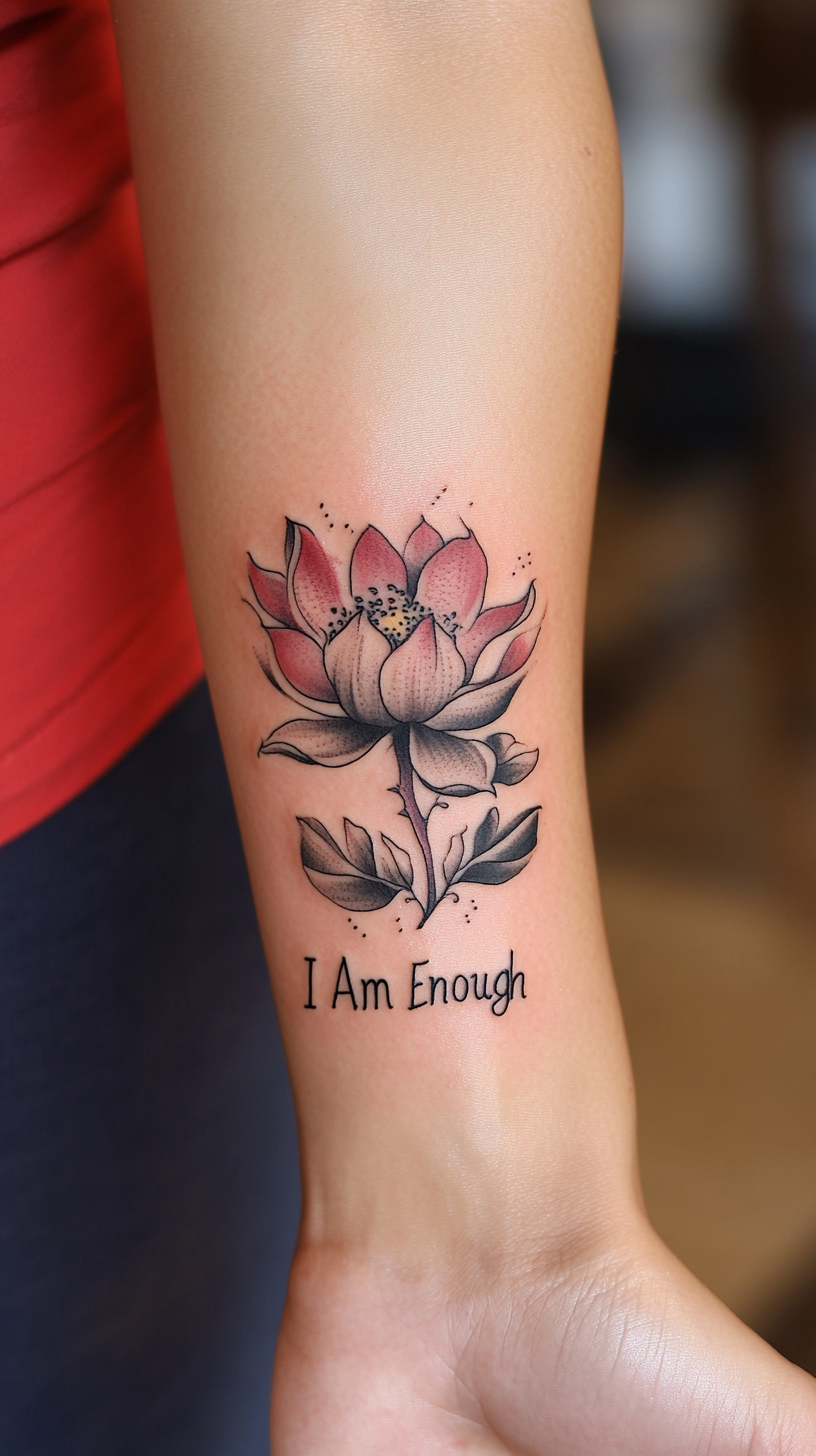
“I Am Enough” tattoos combat the perfectionism that often creeps into yoga practice. This powerful affirmation reminds you that you’re complete just as you are, regardless of your ability to perform advanced asanas. The simple English phrase makes this tattoo accessible and immediately meaningful. Popular placements include the wrist, forearm, or over the heart, where you can easily see it during challenging moments of self-doubt both on and off the mat.
“This Too Shall Pass” Impermanence Reminder
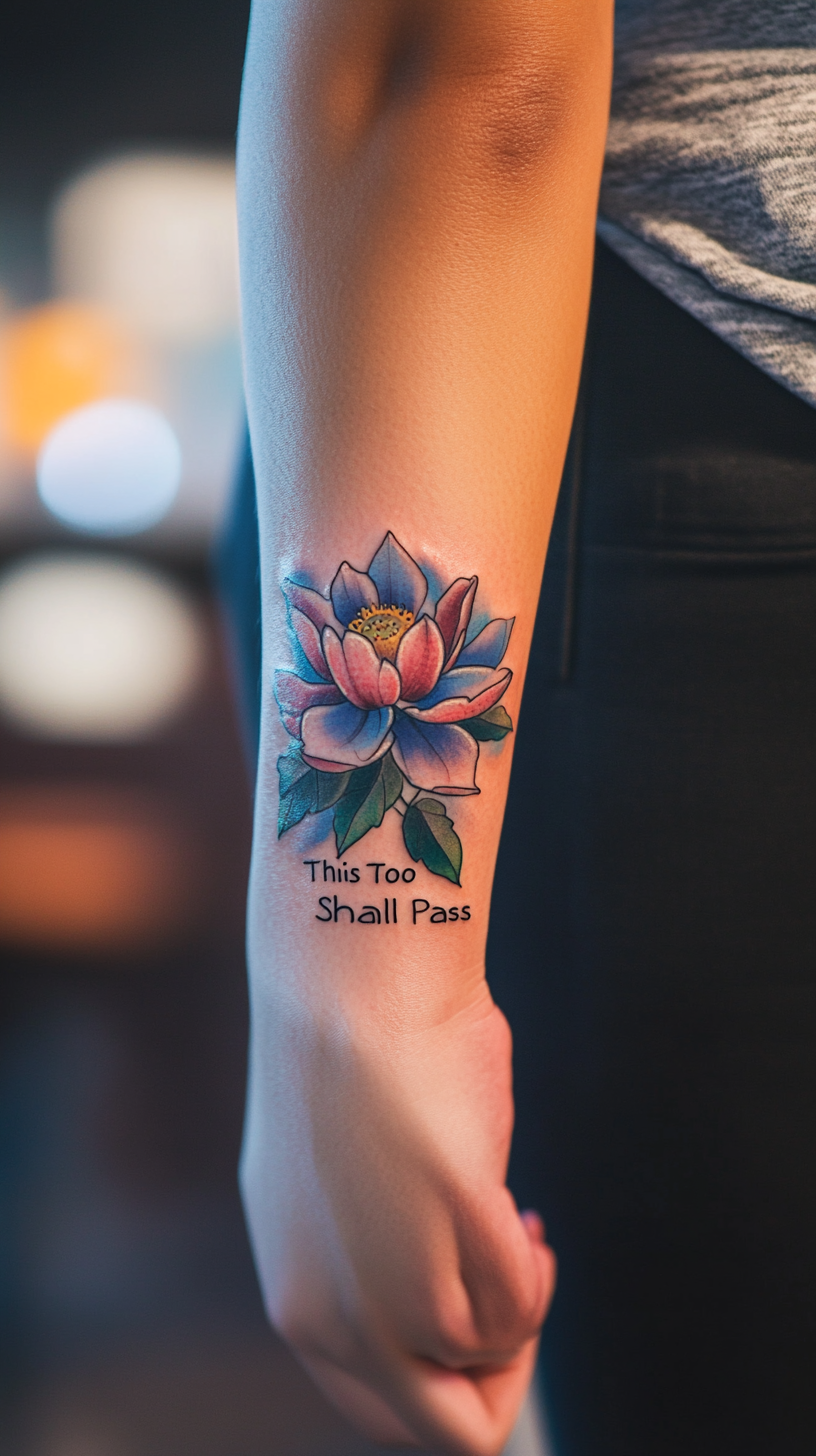
“This Too Shall Pass” tattoos embody the yogic concept of impermanence (anitya). This phrase serves as a powerful reminder that both difficulties and pleasures are temporary states, encouraging detachment and presence. When placed on the wrist, forearm, or ribcage, it provides perspective during both struggles and successes. Many practitioners find this tattoo particularly helpful during challenging life transitions, serving as a touchstone for equanimity.
Personalized Meditation Mantra
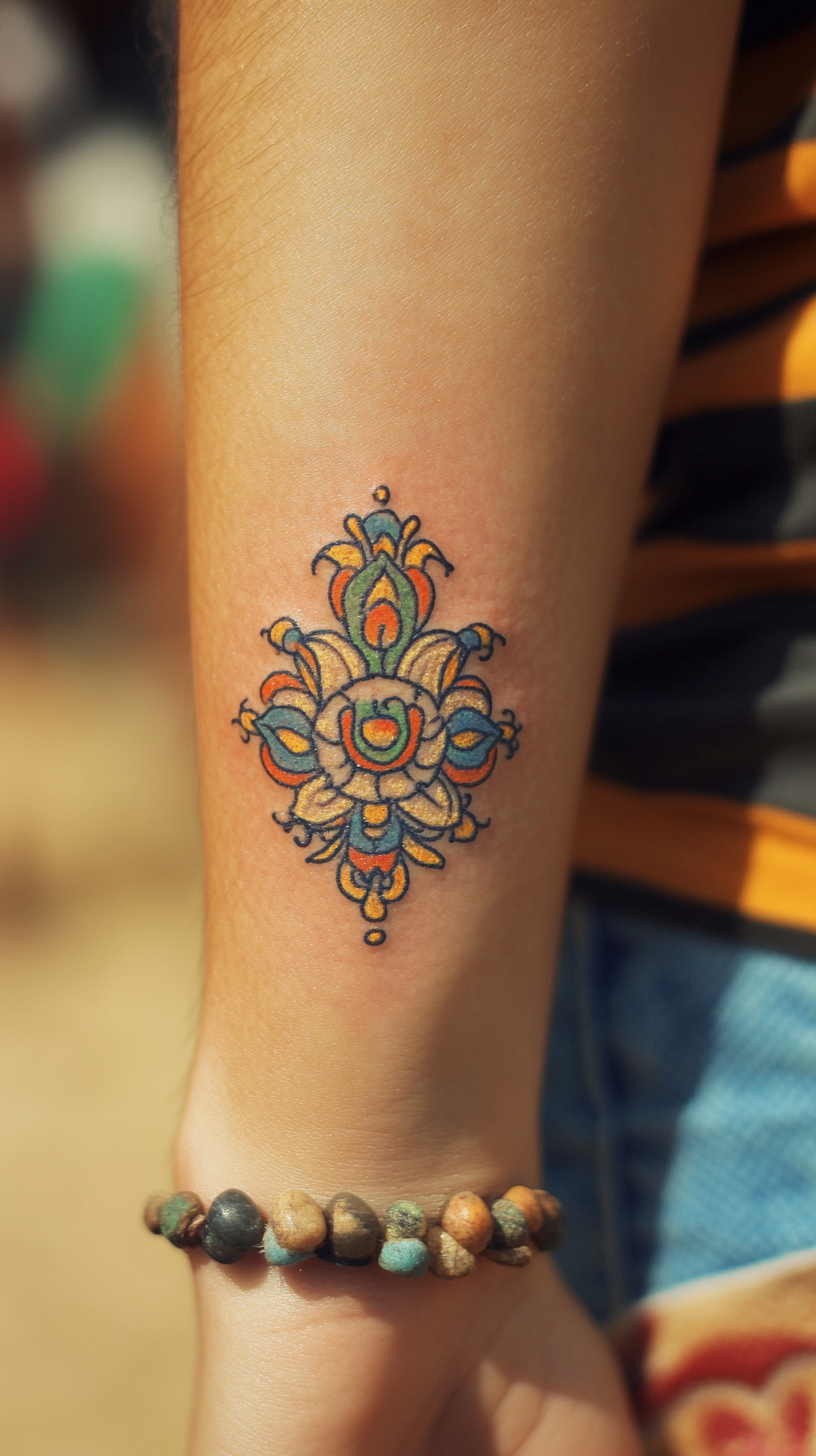
Personalized meditation mantra tattoos immortalize the exact phrase that resonates most deeply with your practice. Whether it’s a portion of a traditional chant, a line from your favorite yoga text, or a phrase that emerged during a important meditation experience, these tattoos hold profound personal significance. They’re often placed where you can see them during meditation—inner wrists, forearms, or thighs—creating a visual focal point that deepens your practice and reinforces your commitment to spiritual growth.
Celebrity Yoga Tattoos That Inspire
Miley Cyrus’s “Om” Symbol
Miley Cyrus sports a small yet powerful Om symbol tattoo on her wrist that serves as a constant reminder of her connection to yoga practice. The placement allows her to see it during asanas, reinforcing her commitment to mindfulness. This ancient Sanskrit symbol represents the universal sound of creation and consciousness, making it a perfect choice for someone like Miley who’s been open about how yoga helped her find balance during career transitions.
Jennifer Aniston’s “Norman” Script
Jennifer Aniston, a devoted yoga practitioner, has a meaningful script tattoo reading “Norman” on her foot in honor of her beloved dog. While not explicitly a yoga symbol, Aniston has spoken about how this tattoo connects to her yoga practice through the concept of devotion and presence. Her yoga instructor Mandy Ingber has noted how Aniston’s dedication to both yoga and commemorating meaningful relationships reflects the yogic principle of mindful attachment.
Lady Gaga’s Unity Symbol
Lady Gaga’s unity tattoo on her shoulder represents the harmony between mind, body, and spirit—central concepts in yoga philosophy. The interconnected circles in her design mirror the principles of chakra alignment that she’s incorporated into her wellness routine. Gaga has been vocal about using yoga to manage chronic pain and maintain mental health, making this tattoo a powerful symbol of her holistic approach to wellbeing.
Shay Mitchell’s Arabic Script
Pretty Little Liars star Shay Mitchell has an Arabic phrase tattoo meaning “faith” on her wrist that she often displays during her Instagram yoga sessions. Mitchell has shared that this tattoo grounds her yoga practice in spiritual intention rather than just physical fitness. The placement allows her to see it during challenging poses, reminding her to maintain faith in her strength and abilities.
Adam Levine’s Sanskrit “Tapas”
Maroon 5 frontman Adam Levine, whose body is covered in artwork, has a Sanskrit “tapas” tattoo representing discipline and burning enthusiasm—a core yoga principle. Levine’s yoga journey began as physical training but evolved into a spiritual practice, reflected in his choice of this philosophical concept. The tattoo serves as a reminder of the groundbreaking power of dedicated practice both on and off the mat.
Russell Brand’s Sanskrit Collection
Russell Brand, an outspoken advocate for yoga and meditation, displays multiple Sanskrit tattoos including “Ahimsa” (non-violence) across his arm. Brand credits yoga with helping him overcome addiction, and his tattoos serve as permanent reminders of his transformation. His Sanskrit collection showcases how deeply yoga philosophy has become integrated into his identity and daily spiritual practice.
Christy Turlington’s Lotus Flower
Supermodel and dedicated yogi Christy Turlington has a delicate lotus flower tattoo that symbolizes purity and spiritual awakening. As the founder of a yoga-inspired wellness brand, Turlington chose this design to represent her personal growth through yoga practice. The lotus, which grows from muddy waters to bloom beautifully, mirrors her journey from the fashion industry to becoming a yoga advocate and humanitarian.
Jessica Alba’s Sanskrit Wrist Tattoo
Jessica Alba sports a delicate Sanskrit tattoo on her wrist that translates to “padma,” meaning lotus. Alba has incorporated yoga into her wellness routine for years, often sharing her practice on social media. Her choice of the lotus symbol connects to her personal journey of motherhood and entrepreneurship, representing how she’s bloomed through challenges while maintaining spiritual groundedness.
David Beckham’s Sanskrit Script
Soccer legend David Beckham has a Sanskrit script tattoo dedicated to his wife Victoria that represents the yogic concept of devotion. Beckham has spoken about how yoga helps maintain his athletic flexibility post-retirement. His tattoo exemplifies how yoga principles can extend beyond the mat to enhance personal relationships through mindful commitment and intentional living.
Katy Perry’s Sanskrit “Anuugacchati Pravaha”
Katy Perry’s Sanskrit phrase tattoo translates to “go with the flow,” embodying the yogic principle of surrender. Perry has been photographed attending yoga classes for years and has spoken about meditation’s impact on her creativity. This tattoo reflects how she’s incorporated the yogic philosophy of non-attachment into her approach to both her career and personal life challenges.
Embracing the Permanent Practice: Why Yoga Tattoos Resonate
Yoga tattoos stand as beautiful embodiments of your spiritual journey inked permanently on your canvas. More than decorative art they serve as daily anchors to your practice and intentions.
Whether you choose an Om symbol on your wrist a flowing Warrior pose along your spine or a personal mantra across your collarbone your yoga tattoo becomes a moving meditation throughout your day.
The perfect yoga tattoo harmonizes meaningful symbolism with thoughtful placement and skilled artistry. When you honor both the ancient traditions and your personal connection to yoga your tattoo transforms into something truly profound.
Your body art tells a story that evolves with you through each pose and breath reminding you that like your yoga practice transformation is both beautiful and continuous.
Frequently Asked Questions
What makes yoga tattoos different from regular tattoos?
Yoga tattoos carry deeper spiritual significance, connecting to ancient yoga philosophy and practices. Unlike purely decorative tattoos, they serve as mindful reminders of one’s yoga journey, embodying concepts like balance, enlightenment, and inner peace. These tattoos often incorporate sacred symbols like Om, lotus flowers, or mandalas that have been meaningful in yoga traditions for thousands of years.
What are the most popular yoga tattoo symbols and their meanings?
The most popular yoga symbols include the Om (representing the universal sound of creation), lotus flower (symbolizing spiritual awakening and purity), Unalome (illustrating the path to enlightenment), mandalas (representing cosmic wholeness), and chakra symbols (showing energy centers). Sanskrit mantras like “Ahimsa” (non-violence) and “Sat Nam” (truth is my identity) are also common choices that remind practitioners of core yoga principles.
Where are the best places to get a yoga-inspired tattoo?
Mindful placement enhances a yoga tattoo’s meaning. Popular locations include the wrist (for daily reminders), spine (for energy flow designs), back of neck (for crown chakra symbols), sternum (for heart-centered symbols), forearm (for mantra visibility), ankle (for grounding symbols), and between shoulder blades (for wing-like designs). Many practitioners align tattoo placement with corresponding chakra locations to amplify the symbol’s energy.
How should I care for my new yoga tattoo?
During the first 48 hours, gently clean with fragrance-free soap, apply thin layers of recommended ointment, avoid submerging in water, and wear loose clothing. Continue gentle cleansing and moisturizing for 2-4 weeks. Avoid direct sun exposure, swimming pools, and hot yoga classes while healing. Modify your yoga practice to prevent stretching the tattooed area. Use sun protection afterward to maintain vibrancy.
How do I choose the right tattoo artist for a yoga-inspired design?
Look for artists with experience in spiritual symbolism and fine linework. Review their portfolio for consistent quality in similar designs. Ask about their understanding of yoga philosophy, their approach to sacred symbols, and their sterilization protocols. Choose someone who respects the spiritual significance of your design and creates a calm, mindful environment during the tattooing process.
Can I practice yoga while my tattoo is healing?
Yes, but with modifications. Avoid poses that stretch, rub, or put pressure on the tattooed area. Skip hot yoga classes for at least 2 weeks as excessive sweating can affect healing. Keep the area clean and moisturized before and after practice. Avoid any contact between your mat and the fresh tattoo. Resume your full practice only when the tattoo is completely healed (typically 3-4 weeks).
What are some meaningful mantra tattoos for yoga practitioners?
Popular yoga mantras include “So Hum” (I am that), “Aham Prema” (I am divine love), “Let Go,” “Just Breathe,” “Ahimsa” (non-violence), “Sat Nam” (truth is my identity), and “Om Shanti” (peace). These short phrases serve as powerful daily reminders of yogic principles. Sanskrit mantras offer authenticity, while English translations provide accessibility. Choose one that resonates deeply with your personal practice.
How ancient is the tradition of yoga-inspired body art?
Yoga-inspired body art dates back over 5,000 years to the Indus Valley civilization. Ancient yoga practitioners used natural pigments to mark their bodies with sacred symbols during rituals and ceremonies. The tradition evolved through various cultures and spiritual practices across India. While modern tattoo techniques differ significantly, many of the symbols and their spiritual meanings remain consistent with those ancient practices.

